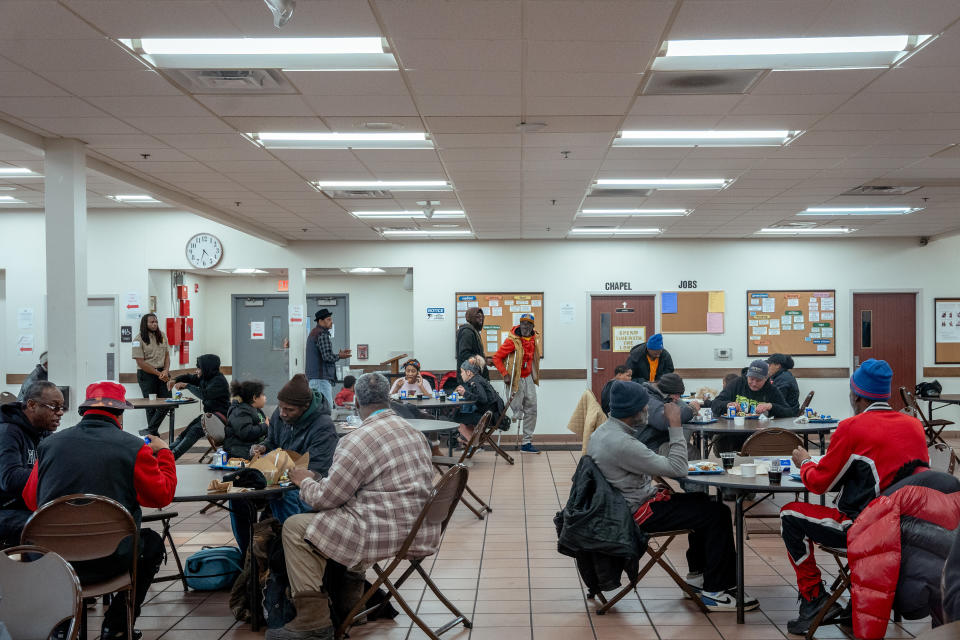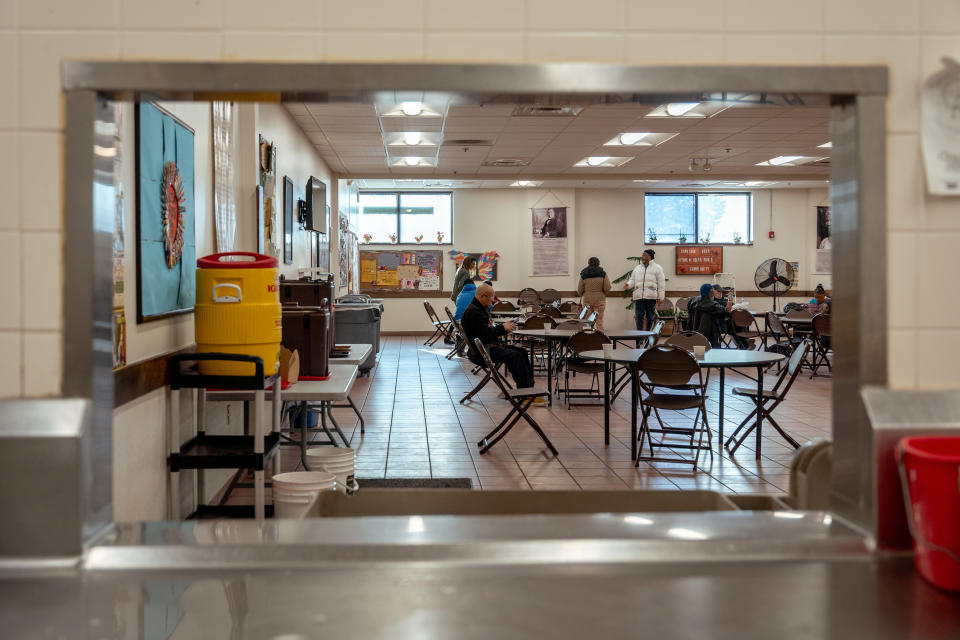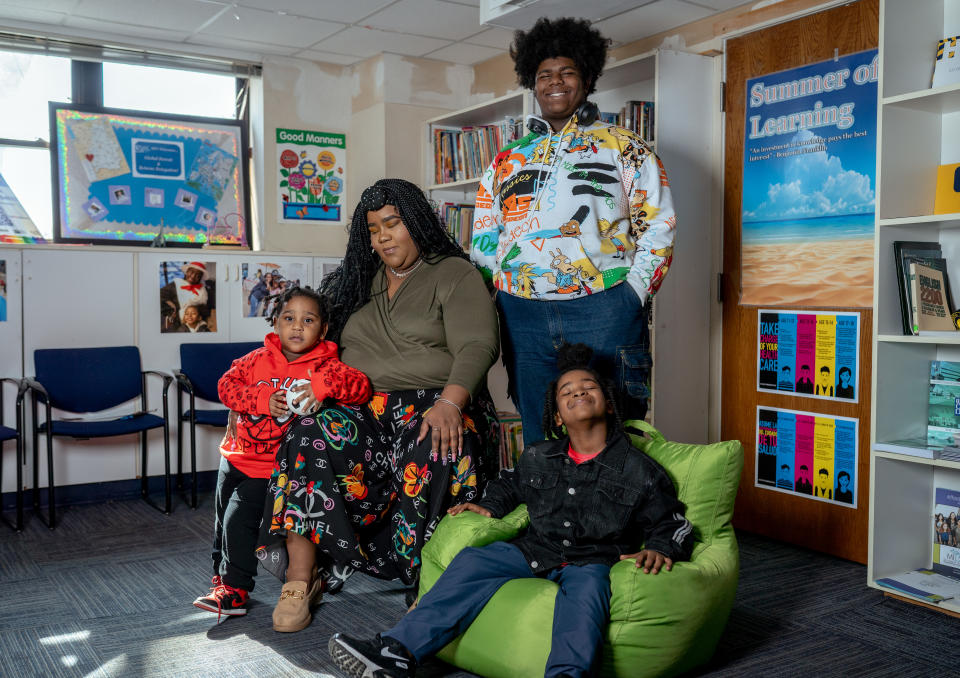Biden’s dreams of ending poverty crumbled. Will he get a second chance?
HOLLAND, Mich. - Amber Bhagwatsingh was so close to being a Biden administration success story.
A mother of five in the town of Holland, on the western edge of Michigan, Bhagwatsingh was finally able to consistently afford rent in 2021, moving on from homeless and domestic violence shelters thanks in part to the help of stimulus checks and a higher child tax credit that came along with the president’s economic assistance package that year.
As the unemployment rate nationally and in Michigan fell over the next year, Bhagwatsingh found a job she loved, handling insurance billing for a dental office just three blocks from her new home. The dentist and his wife were kind and supportive. She was good at the job, and soon the dentist made clear they needed her full time.
But with two toddlers too young for school, Bhagwatsingh discovered that she couldn’t afford the day care that would let her work five days a week. The cost - roughly $290 per child per week, or $3,480 per month, according to a billing estimate reviewed by The Washington Post - would be prohibitive even with a higher full-time salary, which would have netted roughly $2,000 per month in take-home pay.
In late 2021, Congress had allowed the beefed-up child tax credit that helped her to expire, and legislation to direct more federal aid to child care died as well. Unable to afford the full-time care she needed, Bhagwatsingh lost her job in the dental office, and now she works two days a week as a clerk at the local courthouse - trying to thread the needle between earning enough to qualify for a state subsidy and still making little enough to keep the subsidy and her food stamps. She struggles to afford groceries, gas and other essentials, and she said she lives in constant fear of becoming homeless again.
“My son turns 14 tomorrow, and my 2-year-old turns 3 on Saturday - I had to tell them Mom’s gifts will come a little later,” Bhagwatsingh, 36, said in February. She said she voted for President Biden in 2020 but doesn’t plan to do so this year. “I tell myself, ‘You don’t have time to fall apart right now. … I try not to actively think about it, but it brings on such an overwhelming sense of despair.’”
Biden came into office promising to expand the safety net as no president has since Lyndon B. Johnson’s 1960s-era Great Society, through sweeping legislation to help the economy recover from the covid pandemic. But even though Democrats controlled both chambers of Congress until last year, he couldn’t fulfill his most ambitious goals, stymied especially by opposition from Republicans and Sen. Joe Manchin III (D-W.Va.), who objected to sending more cash assistance to people as inflation took off.
Most Americans have experienced economic benefits nonetheless, seeing rising wages, low unemployment and increased household wealth. But more than 40 million people - mostly outside the labor market - remain in poverty. Inflation, though it’s easing, has exacerbated some of the worst problems: Food insecurity, homelessness and child poverty are all up since 2021, when lawmakers expanded the federal safety net to cushion the economy from the pandemic, largely through temporary measures that have since expired.
It is unclear how much these issues will shape the upcoming 2024 presidential election, with more voters clamoring for relief from inflation than demanding sweeping new social programs. But Biden’s expansive ambitions to bolster the safety net may not help the president much even among its intended beneficiaries. In swing states like Michigan, where Biden’s campaign needs backing from women and people of color who helped him win in 2020, many people who hoped federal assistance could give them a boost have been disappointed. In interviews, more than two dozen people across Michigan struggling with child care, housing or hunger were unaware of Biden’s plans to expand the safety net - and unsure, at least for now, about how they’ll vote this fall.
“This comes up in our focus groups all the time: It’s getting harder to pay for kids, and it’s a key part of why people feel pessimistic,” said Celinda Lake, a Democratic pollster who worked for Biden in 2020.
Biden’s team is trying to make clear that the White House wants to do more. Treasury Secretary Janet L. Yellen told reporters in February that a child-care expansion remains one of her most urgent priorities, and the president also emphasized the need to act on child care, paid family leave and eldercare in his State of the Union address. Senior Democrats on Capitol Hill and inside the White House say reviving Biden’s domestic safety net proposals - particularly on child care - would probably be their top legislative priority if they win full control of government in 2025, underscoring the policy stakes of the upcoming election. Trump consistently aimed to cut the safety net during his term.
“It feels like the next thing up, in the same way climate was the next thing up,” said Tobin Marcus, head of U.S. policy and politics at Wolfe Research and a former economic policy staffer for Biden. “The ‘care economy’ broadly is the obvious unfinished work of his first term.”
Of more than a half-dozen safety net plans Biden pushed in his initial “Build Back Better” agenda, perhaps none was as broadly important to senior Democratic officials as the effort to expand child care. Lack of care drives parents like Bhagwatsingh out of the labor market, hurting the economy overall and contributing to lifelong inequality, depriving poorer families of the chance to start their kids’ education sooner. Pollsters say the issue is a winning one for Democrats at the ballot box, and longtime aides say reducing child-care costs for working-class parents is a matter of genuine conviction for the president.
Yet over the past year of Biden’s administration, those costs have soared faster than overall inflation. The expiration last fall of covid-era aid for providers stung: The end of aid in Michigan, for instance, was estimated to lead to the closure of 1,200 providers serving 56,000 kids. The cost of infant care on average in Michigan is $12,238 per year, according to Monique Stanton, president of the Michigan League for Public Policy, a nonprofit group.
That’s about 36 percent of the average income for single mothers in Michigan of $34,000. Child care is considered unaffordable if it costs more than 7 percent of a family’s annual budget.
Biden’s plans have focused on expanding federal subsidies that would cap the amount families spend on child care. But many parents in Michigan said they had no idea Democrats were even talking about such legislation.
The same week in December 2021 that it became clear Biden wouldn’t have the votes to keep the higher child tax credit, D’Juana Henderson and her three children were evicted from their home in Detroit.
Henderson had been fired in November from her job as a clerk in the intensive care unit of a Detroit hospital because her youngest child had severe food allergies, which led to frequent emergency room visits that required her to miss work. Newly unemployed, the single mother also suddenly lost state assistance for child care, which parents only receive if they have at least some earned income. The federal government provided no support either. Even as her son’s health improved, she had no child care, which rendered it nearly impossible to hunt for a new job. Her eviction then kicked off seven months of homelessness, as she tried to project an air of normalcy for the kids while bouncing between shelters and hotel rooms, eating frozen pizza and fast food.
“All of this happened because I could not afford child care. And you’re dying inside because you feel like you failed as a parent. There is no worse feeling than that,” said Henderson, 38, wiping away tears. She voted for Biden in 2020 but said she is unlikely to do so again, citing his failure to fulfill promises to increase help for parents like her. “He didn’t live up to his policies on child care - he didn’t live up to his policies on helping parents. He talked a lot about investing in minority communities, and I haven’t seen it.”
Other parents in Michigan had similar stories.
After two years struggling to find care for his son, Obed Pamales Jr. finally secured a slot for him at a center in downtown Detroit. But there was a catch: Day care only lasts from 3:30 to 7 p.m., leaving most of the workday uncovered.
A home renovator with a knack for remodeling bathrooms, Pamales now has no choice but to bring his 3-year-old from job to job, first making sure there are no loose nails for his boy to step on. Obed Pamales III waits in a folding chair, watching “Sesame Street” videos on his dad’s phone instead of learning with classmates his age.
“I had some hope for Biden,” said Pamales, who voted for Biden in 2020 but said he is unlikely to do so again. “But I have not seen an improvement in my life.”
Child care isn’t the only area where Biden sought to further expand the safety net but fell short. The administration made the formula for food stamps more generous, leading to the biggest increase in benefits in the program’s history. But that was offset by the expiration of a separate covid increase for food stamps, as well as the fastest rise in grocery prices in four decades. The result was that poor families with four kids saw their benefit cut in March 2023 from $939 to $429, according to Michigan’s Health and Human Services Department. And poverty rose from 7.8 percent to 12.4 percent for all people in 2022, more than doubling - from 5.2 percent to 12.4 percent - for children.
Now demand for food assistance is soaring.
Dressed in his brown habit, Brother Gary Wegner, executive director of Detroit’s Capuchin Soup Kitchen, watched as more than two dozen people quietly formed a line for an early dinner of fried chicken with hot sauce and peas over the winter.
Thanks to pandemic assistance, Capuchin had seen demand fall from roughly 1,000 meals per day to a few hundred. Now, the soup kitchen is above pre-covid levels. Demand has increased by roughly 80 percent over the past year, Wegner said.
Sherry Evans, 33, had brought her 3-year-old daughter, Ivory, in a pink puffer coat to the Capuchin Soup Kitchen on a recent frigid Wednesday. She said she is trying to care for three children with no income; they had come on the bus from a YMCA homeless shelter. Evans should have qualified for $5,600 in stimulus funding and $9,600 from Biden’s expanded child tax credit in 2021. She said she received neither, probably because she hadn’t had to file taxes the previous year, which meant the Internal Revenue Service did not have her information. She was unaware of Biden’s push to revive the expanded child benefit so it would help families like hers.
“It’s tough. Everyone wants the best for their children,” said Evans, zipping up Ivory’s coat as they braced for harsh winds whipping outside. “But it’s OK. It can only get better.”
Related Content
After voting to legalize weed, Marylanders are mixed on impact, poll finds
Shadowing Trump’s attacks on mental fitness — his own father’s dementia
In Wisconsin, a vote for Biden or Trump could come down to grocery prices










